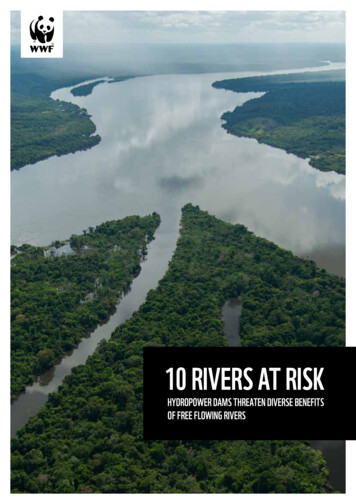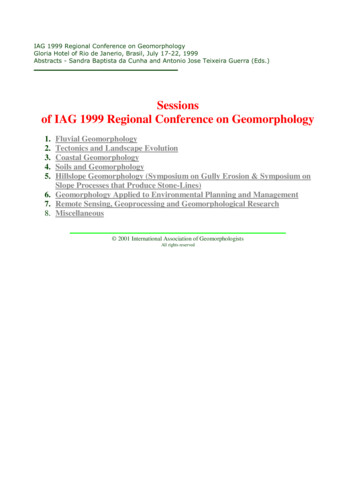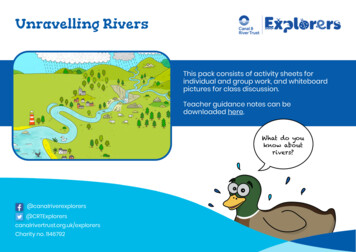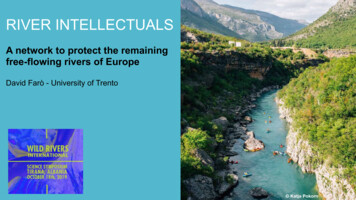
Transcription
10 RIVERS AT RISKHYDROPOWER DAMS THREATEN DIVERSE BENEFITSOF FREE FLOWING RIVERS
CONTENTSINTRODUCTIONRIVERS AT RISKPublished by WWFISBN 978 - 2 - 88085 - 313 - 6Design by Ender ErgünWWF, 28 rue Mauverney, 1196 Gland, Switzerland.Tel. 41 22 364 9111 CH-550.0.128.920-7WWF and World Wide Fund for Nature trademarks and1986 Panda Symbol are owned by WWF-World Wide FundFor Nature (formerly World Wildlife Fund).All rights reserved. For contact details and further information, please visit ourinternational website at www.panda.orgCover photography: WWF-Brazil/Zig Koch Shutterstock / WWF10 RIVERS AT RISKSEPIK (PAPUA NEW GUINEA)LOWER MEKONG (LAOS)IRRAWADDY (MYANMAR)MARA (KENYA)KAVANGO (ANGOLA)VJOSA (ALBANIA)ISEL (AUSTRIA)VISTULA (POLAND)TAPAJOS (BRAZIL)UPPER PARAGUAY RIVER (BRAZIL)CONCLUSION412141618202224262830323
INTRODUCTIONRivers flow through the heart of human history. For millennia, they providedwater, food and transport, fuelling the rise of civilizations. In more recent times,we have tamed them – damming, dredging and diverting them to serve theneeds of the agricultural and industrial revolutions. And in the process, silently,we have destroyed many of the benefits that healthy, free flowing rivers provideto people and nature.The traditional importance of rivers to societies and economies is clear: around2 billion people get their drinking water directly from rivers, which also providewater to 62 per cent of the world’s irrigated farmland, directly supporting abouta quarter of our total global food production. Meanwhile, hydropower generatesabout 17 per cent of global electricity.But healthy, free flowing rivers are so much more than just water pipes. Theirdynamic flow of water, sediments and nutrients sustain freshwater fisheries thatare critical to the food security of over 200 million people, fertilise floodplainfields that are among the most productive on Earth, help provide a buffer toprotect cities from floods, and keep heavily populated deltas above the risingseas. Despite taking up a tiny fraction of the Earth’s surface, they are also amongthe most biodiverse ecosystems on the planet, sustaining not only a wealth offreshwater species but also a host of terrestrial and marine ones as well. Adriano Gambarini / WWF-Brazil10 RIVERS AT RISK5
But these ‘hidden’ benefits have invariably beenundervalued and overlooked by decision makers – until,that is, they are lost. Healthy rivers are now the exceptionrather than the rule. The clearest sign of the damage wehave done - and are still doing - is the shocking decline infreshwater biodiversity. Over the past 50 years, freshwaterspecies populations have collapsed by 84 per cent onaverage.Today, only a third of the world’s long rivers – over 1,000km in length – remain free-flowing. Keeping them thatway is critical to global efforts to tackle the climate andnature crises as well as to the local communities, indigenouspeople and species that depend directly on them. Yet manyof these are now at risk – as are hundreds of shorter riversand streams across the world – from a wave of hydropowerdams that are the legacy of days when there were no viablerenewable alternatives and when development decisions didnot factor in the diverse benefits of healthy rivers.In total, more than 3,700 large, new hydropower dams areplanned or under construction, threatening to fragmentmany of the world’s remaining free flowing rivers – as wellas the free flowing lower stretches of some major rivers.Take the 10 rivers in this report. From the Amazon to theAlps and the Mara to the Mekong, we highlight how 20thcentury thinking about rivers and hydropower risks greenlighting decisions that are unsustainable and irreversible– decisions that will fragment these dynamic, living riversand impact over 80 million people, who depend on themfor fish, farms and a sustainable future. Decisions that areblind to the renewable revolution - the plunging price ofsolar and wind generation and new storage technologies that has undermined the rationale for harmful, high-impacthydropower.For the first time, we can meet our global climate andenergy goals without damming the world’s remaining freeflowing rivers. We do not need to stick to out-dated modelsthat suggest that a huge increase in new hydropowercapacity is still required to achieve these goals. Currentprojections within IPCC models, for example, foreseea sizeable expansion in new hydropower, which would Hkun Lat / WWF-Myanmar10 RIVERS AT RISK7
fragment another 260,000km of river, with more than70 per cent of new development taking place in highlyproductive and biodiverse river basins. But theseforecasts underestimate the impact of the renewablerevolution.Wind and solar power have improved dramatically inefficiency terms in recent years, while their prices haveplummeted. In many cases, solar is now the cheapestform of generation – and costs are expected to keep onfalling. It is now possible for countries to create powergrids that are low carbon, low cost and low conflict withrivers and communities – a LowCx3 approach that wouldavoid up to 90 per cent of potential hydropower-relatedriver fragmentation and offers a brighter future forpeople, nature and climate.This renewable revolution means the world could keepglobal warming below 1.5C and provide power to thebillion people who currently lack access to electricitywithout sacrificing the diverse benefits of free flowingrivers, like the Irrawaddy, Kavango, Tapajos and Vjosa– or the other six rivers at risk in this report. But it willrequire countries, developers and investors to acceleratethe renewable revolution, rather than sticking with theunsustainable status quo.In some regions, hydropower may play a role in LowCx3power systems, particularly in helping to balance theintermittent power supplies of wind and solar, and incountries which suffer low electricity access. In others,like Europe which already boasts the world’s mostfragmented rivers, new hydropower should not bepart of the energy mix. Overall, the challenge now is toavoid giving the go ahead to the type of poorly-planned,harmful hydropower projects detailed in this report.fish migration routes, threatening the future of freshwaterfisheries that are vital to local communities and indigenouspeople as well as food for endangered river dolphins. Orplanned dams on the Mara River in Kenya that would impactover 1 million people downstream as well as the world’sbest known wildlife migration. Or an utterly unnecessaryhydropower scheme on the lower Vistula in Poland, whichwould seal the fate of the entire basin once and for all. Ora proposed dam on Angola’s Kavango River, which wouldthreaten the future of the Okavango Delta World HeritageSite – and the extraordinary biodiversity that depends on itand which sustains local communities and fuels Botswana’stourism industry.The global climate and nature crises pose an existential threatto our future. Continuing to adhere to 20th Century energy‘solutions’ is a recipe for disaster. Such as damming Europe’slast free flowing river – the Vjosa in Albania – to produce anegligible amount of power. 21st Century thinking would optfor sustainable renewable alternatives, while transformingthis spectacular river into a National Park rather than yetanother dam-choked river in Europe. LowCx3 thinking wouldalso avoid a series of new hydropower dams on the lowerMekong in Laos, which would threaten the world’s largestfreshwater fishery and the resilience of the downstream delta.Already the Mekong delta is sinking or shrinking due to a lackof sediment flowing down South East Asia’s mightiest river.New dams on the mainstem would trap even more sediment,and speed up the erosion of the delta, putting at risk one ofthe region’s richest rice baskets, thriving economies, and thehomes and livelihoods of millions.High impact hydropower projects like these will provideprofits to developers and their political and business alliesin the short term – with rivers, communities and natureRenewable alternatives could replace the generatingpower of the proposed Myitsone dam on the Irrawaddyriver: there will never be any way to replace thesediment, fisheries and other ecosystem servicesthat would be lost if the destructive dam were built.The benefits of a free flowing Sepik river – the mostbiodiverse in Papua New Guinea - are more valuable tothe 400,000 people who depend on it than the promisedriches from a mine that a planned hydropower damwould fuel: riches that would end up in the pockets ofpeople far from Sepik. At the other end of the scale, smallhydropower projects on the much shorter (and glacial)Isel river in the Austrian Alps will provide negligibleadditional power in exchange for substantial social andenvironmental costs. In South America, the combinedimpact of numerous small dams in its headwatersthreaten the natural water flow that is the lifeblood ofthe Pantanal, the world’s largest tropical wetland – thehealth of which is critical to local communities anddistant cities as well as home to over 4,000 species.Or take the dam on the Tapajos, one of the mostimportant tributaries of the Amazon: it would block10 RIVERS AT RISK depositphotos / WWF9
paying the long term price. Companies and supply chainsthat depend on healthy rivers will also be left to count thecost. As, increasingly, will insurers. Already prone to greaterschedule delays and cost overruns than other renewablepower projects, hydropower dams in many areas willbecome increasingly risky due to the impacts of climatechange. More intense droughts will cut power generation,while more extreme storms and rainfall could threaten thestructural integrity of dams themselves.flowing rivers and protected areas – where 500 hydropowerdams are currently planned. It’s also well past the pointwhen public subsidies should be handed out to harmfulhydropower, particularly small hydropower projects inEurope that are unnecessary and invariably only viablebecause of the subsidies. Indeed, in Europe, it’s actuallytime to invest in the very opposite approach – in removingobsolete hydropower dams, which is a proven way to bringlife back to the continent’s dying rivers.The good news is that we are not locked into this pathyet. We can still opt for a brighter future by ensuring thatcountries pursue the best overall LowCx3 energy mix foreach situation, which will involve taking a system-wideapproach and factoring the benefits of healthy rivers andthe realities of the renewable revolution into developmentdecisions. This would help to save the 10 rivers in this report– and many others around the world - for the benefit ofpeople and nature.Indeed, these are both key pillars of the EmergencyRecovery Plan for freshwater biodiversity: keep rivers freeflowing and restore natural flows whenever possible. It iscritical for this plan and indicators to track rivers’ status tobe incorporated into the new global framework for natureto be agreed at the Convention on Biological Diversityconference in China in 2022 – and for countries to thenlive up to their commitments. This would turn the tide,bending the curve of freshwater biodiversity from decadesof decline upwards towards recovery and a nature-positiveand resilient future. It would also boost global efforts toadapt to the worsening impacts of climate change since freeflowing rivers and healthy, connected floodplains are criticalto building resilience, particularly in the world’s increasinglyvulnerable deltas.In some situations, low impact hydropower - includingmodernising existing plants, adding turbines to storagedams and LowCx3 pumped storage - will still be part of thebest overall energy mix. Mexico has already announced thatit will not build new hydropower dams but will still be ableto generate more power by investing in refurbishing andretrofitting existing dams. Shutterstock / foxbat / WWF10 RIVERS AT RISKHowever, new hydropower developments should avoid freeAnd it would make it very hard for governments, developersand investors to plough ahead with the harmful hydropowerprojects that loom over the 10 rivers at risk in this report.11
SEPIK RIVER / Papua New Guinea“It is our identity, our life, and the heartbeat of our culture. Alife without the Sepik River as we know it would devastate ourcommunities forever.” Emmanuel Peni, community campaignerFrom its source in Papua New Guinea’s northern, cloudforested mountains, the Sepik river winds its way eastwardsover 1,120km down to the sea through tropical rainforest andlowland mangroves, diverse habitats of global significancefor biodiversity - and life-sustaining importance for localcommunities.With 1,500 lakes and other associated wetlands, the Sepik isthe longest free flowing river system in PNG. It is also one ofthe largest and most intact freshwater basins in the whole ofthe Asia Pacific region, encompassing two Global 200 ecoregions, three endemic bird areas and three centres of plant diversity. The Upper Basin came close to being nominated forWorld Heritage status in 2006, while the river was proposedas a Ramsar Wetland of International Importance in 2017.Although the Sepik basin is one of the least developed areasin PNG, it’s nevertheless home to some 430,000 people,who depend almost entirely on products from the river andits surrounding forests for their livelihoods. The Sepik Riverprovides them with food, water for drinking, washing andtransport, and it fertilizes its banks that sustain fruit andvegetable gardens, and plantations of sago and tobacco. Thelocal economy is built on the sale of sago, fish, freshwaterprawns, eels, turtles, and the eggs, skins and meat of croco-diles. In a richly diverse region in cultural terms– more than 300 languages are spoken in an areathe size of France – the river is at the beatingheart of every village.But PNG’s rich natural resources could now provedisastrous for the people ofthe Sepik River. PanAust– an Australian-registered but actually Chinesestate-ownedcompany– is on thepoint of Brent Stirton / Getty ImagesSAVE THE SEPIKbeginning development of the largest mine in the country andone of the largest in the world to get at the region’s depositsof copper, silver and gold.The giant plan on the Frieda river, a major tributary of theSepik, includes the open-pit mine itself as well as a hydropower plant, power grid, and road, air and seaport construction. It also includes a tailings dam (where mining waste andtoxic by-products are stored) two and a half times the size ofSydney harbour.With estimated annual revenues of US 1.5 billion for the next30 years, it’s not hard to see why PanAust and its backerswant the project to go ahead. Although it’s less obvious whythe government would since tax concessions andthe company’s complex, foreign ownershipstructure means that the people of PNGwill see little of that - the people of theSepik even less. Meanwhile, local communities will bear the brunt of the socialand environmental impacts.Opponents warn that the minewould be a disaster waitingto happen: in an area ofhigh seismic activity andextreme rainfall, the chances of damage to the tailingsdam are high – yet PanAust’sEnvironmental Impact Statementlacked any information or analysis on the possibility of adam break. Running mining activities over an area of some16,000 hectares within the Sepik river basin will devastatethe local region even without the possibility of a catastrophicdam break. The hydropower dam needed to run the mine willseverely impact the natural flow of the Sepik that is criticalfor people and nature downstream, and the toxic chemicalsfrom the mineworks could poison the river.The United Nations was so concerned about the proposeddevelopment that 10 special rapporteurs looked into it. Theycame away voicing “serious concerns” that “the project and itsimplementation so far appears to disregard the human rightsof those affected”. Free prior and informed consent has beenignored.Heading the campaign for a total ban on the mine development are the people of the Sepik River themselves, who havecome together to campaign to Save The Sepik. In an unprecedented move, chiefs from 28 haus tambarans – ‘spirithouses’ that are the cultural and political hub of villages inthe region – representing 78,000 people issued a collectiveSupreme Sukundimi Declaration demanding an end to theproject.“We have gathered together as Guardians of the River tostand firm as one,” said the Chiefs. “The Sepik River is notours. We are only vessels of the Sepik Spirit that dwells toprotect it. We will guard it with our lives.” Brent Stirton / Getty Images10 RIVERS AT RISK13
LOWER MEKONG / LaosMEKONG BLUESThe Mekong – flowing nearly 5,000km from the Tibetanplateau to the sea – is one of the world’s great rivers. Hometo over 1,000 fish species, the lower Mekong supports one ofthe world’s largest and most productive freshwater fisheries,yielding around 2 million tonnes of fish per year. What’smore, the Mekong delta is the rice bowl of Viet Nam with itsfertile fields - nourished by the sediment carried downstreamby the natural cycles of the river - producing around half ofthe country’s total rice harvest.It’s hard to overstate quite how important a healthy, freeflowing lower Mekong is to the 60 million people who livethere. Fish are the cheapest source of animal protein in theregion, and more than two-thirds of the population of thelower basin benefit from wild capture fisheries. Meanwhile,rice provides around 75 per cent of the Vietnamesepopulation’s daily calories as well as significant export income.But all this is under threat from four large hydropower dams,which Laos plans to build across the main channel of theriver.Laos wants to use hydropower to become the ‘battery ofSoutheast Asia’, selling electricity across the border toThailand and other states. It has constructed more than 50hydropower dams in its portion of the Mekong basin over thepast 15 years, and a further 50 are under construction aroundthe country. One of the most controversial dams - Xayaburion the Mekong’s mainstem - is already operational.The proposed new dams would devastate the downstreamfisheries and fields that so many people rely on, not tomention the threat they would pose to critically endangeredspecies, such as the Mekong’s 89 surviving river dolphinsand the Mekong Giant catfish. One of the dams would alsonegatively impact the World Heritage site of Luang Prabang.A two-year drought in the region underlined the stress that theMekong is experiencing – fishers say their stocks have fallendramatically, while depleted sediment flows have increasedthe risk that river banks, buildings, roads, bridges and farmland will collapse and that saltwater will intrude ever further,impacting both prime agricultural land and the water supply. Nicolas Axelrod / Ruom / WWF-Greater Mekong, Thomas Cristofoletti / WWF-US, Gerry Ryan / WWF-Greater Mekong10 RIVERS AT RISKIndeed, stretches of the famously muddy Mekong have turnedblue in recent years. To some, it may look beautiful but ahealthy Mekong should be brown with sediment. The delta isalready sinking and shrinking because existing dams on theupper Mekong and unsustainable sand mining have slashedthe amount of sediment reaching the delta. Building all theplanned dams on the Mekong could see the sediment supplyreduced to just 10 per cent of natural levels. Coupled withexcessive groundwater abstraction and sea level rise due toclimate change, this could result in half of this great deltadisappearing under the waves by the end of the century.The irony of all this is that Laos can’t afford to build thesedams, and the ‘battery of SE Asia’ may turn out to beirrelevant and unused. Between them, the dams on the mainchannel of the Mekong will cost around US 12.5 billion.With a GDP of only US 18 billion, Laos will have to fund theconstruction through bank debt – and Laos has already lostcontrol of its national power grid, after its sovereign reservesfell during the Covid pandemic. At the same time, demandin Thailand has slumped and it has not confirmed that it willpurchase any of Laos’ electricity. Thailand has also raisedmultiple concerns over the environmental impacts of theUS 2 billion Sanakham dam, flatly rejecting the “insufficientand out of date” technical report supplied by Laos.What’s more, just across the border, Cambodia hasdemonstrated that another path is possible. In 2020, thegovernment imposed a 10-year moratorium on dams onthe mainstem, halting plans to construct the controversialSambor and Stung Treng hydropower projects. This widelypraised decision seems to have been partly based on thedevastating impact that the proposed dams would have hadon the river’s hugely productive fisheries – fisheries that feedmillions of people in Cambodia and Viet Nam. Subsequently,Cambodia has joined other states in the region, includingChina, Thailand and Viet Nam, in pumping more investmentinto solar power.But Laos seems intent on carrying on dam construction,without factoring in the impact the new dams will havenot only on the people of Laos but even more so oncommunities and countries downstream. Cambodia hasshown that the days of building new hydropower dams onthe Lower Mekong’s mainstem are - or should be - over.There are renewable alternatives now that will not threatenirreplaceable fisheries or help speed up the sinking andshrinking of the delta. Keeping the lower Mekong free flowingis the best and most cost effective adaptation strategy fora region that is one of the most vulnerable in the world toclimate change. Will Laos see the light? Thomas Cristofoletti / WWF-UK, WWF / Greg Funnell15
IRRAWADDY / Myanmarsediment supply will be drastically reduced if plans for aUS 3.6 billion, 6,000-megawatt hydropower dam at Myitsoneever get the final go-ahead.noted, “if constructed, the Myitsone dam would break riverconnectivity, trap sediment, and alter the river flow on a widescale.”Fifty percent of people in Myanmar lack access to electricity,but there are better, lower impact ways to generate powerthan the controversial Myitsone dam. The Chinese-fundedproject at the head of the Irrawaddy River – in an area steepedin cultural and spiritual significance – has been deeplyunpopular with the people of Myanmar since it was firstmooted, uniting groups across the country in protest.But despite clear warnings from scientists and the oppositionof around 85 per cent of the population, there’s a very realpossibility that the dam could still be built. Political turmoilin Myanmar, ongoing pressure from the project’s Chinesebackers, and a lack of transparency are creating an uncertainfuture for the Irrawaddy. A holistic, common vision for thisfast-developing nation’s energy generation – which factorsin the diverse benefits of free flowing rivers as well as thetrue social and environmental costs of hydropower on rivers,nature and people – is urgently needed before it’s too late.Construction plans have been on hold since 2011, and acomprehensive Strategic Environmental Assessment (SEA)released in 2018 by the International Finance Corporationstrongly recommends against building the dam, alongwith any other hydropower projects on the main stems ofMyanmar’s major rivers, including the Salween. As the SEAThe plunging price of alternative renewables, such assolar and wind, means that countries can generate powerfrom sources that are low carbon, low cost and low impactwith rivers and communities. Investing in this renewablerevolution will enable Myanmar to avoid high impact projectssuch as Myitsone – to generate power for its people, withoutsacrificing the life-giving services of the Irrawaddy river.KEEP MYANMAR’SLIFEBLOOD FREE FLOWINGFew nations on Earth rely on a river as much as Myanmarrelies on the mighty Irrawaddy – one of the last two, long,free flowing rivers in Southeast Asia.Starting at the confluence of the N’mai and Mali rivers,themselves fed by the glaciers of the Himalayas, it flows over2,000km from north to south and passes through 12 diverseecoregions to its delta on the Andaman Sea. On the way, itprovides diverse values that underpin Myanmar’s society andeconomy, from sustaining productive freshwater fisheries tonourishing the country’s rice paddies, and supplying waterfor communities, cities and companies.Home to 34 million people, the hugely biodiverse Irrawaddybasin also shelters 1,400 mammal, bird and reptile species,and an estimated 550 species of fish, many of which have yetto be scientifically ‘discovered’. It’s also one of the last refugesof the eponymous Irrawaddy dolphin – fewer than 80 of thecritically endangered animals remain in the river.As well as its importance for people and nature, theIrrawaddy carries a particularly high sediment load: the 260million tonnes that flow downstream each year are essentialfor keeping the fertile lands of its densely populated, ricegrowing delta from sinking and shrinking. But this critical Hkun Lat / WWF-Myanmar10 RIVERS AT RISK17
MAASAI MARA / Kenya / TanzaniaDAMS COULD DOOMMARA MIGRATIONStretching 395km from its source in Kenya’s Rift Valley towhere it flows into Lake Victoria in Tanzania, the Mara Riverplays an essential role in one of the world’s greatest wildlifespectacles. Its basin hosts the highest density of large herbivores on the planet, and each year more than a million wildebeest, half a million gazelle and 200,000 zebra migrate fromthe Serengeti park in Tanzania to the Maasai Mara reservein Kenya in search of water and grazing. As the only sourceof water in the dry season, the Mara River makes this vastexodus possible.A recent WWF report provided the first in-depth study of theremarkable freshwater biodiversity in the basin, identifying473 endemic species, including 4 mammals, 20 amphibians,40 fishes, 88 waterbirds and 141 vascular plants. Other endemic species remain to be described.But the health of the free flowing Mara is also critical forpeople, sustaining the livelihoods of 1.1 million people, whilecontributing between 10-15 per cent of the GDP of both Kenyaand Tanzania. Tourists visit from all over the world to see thewildlife, while agricultural land – nourished by the river – isfast increasing in area. The river also helps to sustain the con-tinent’s most productive freshwater fisheries in Lake Victoria,which yield about a million tonnes of fish each year.But the river is at risk. In recent years, droughts coupled withhuman activities, including water abstraction for agricultureand tourism, have led to erratic flows, upsetting the delicatenatural balance and degrading vital wetlands. With the basin’shuman population growing by three per cent each year andthe increasing impacts of climate change, these pressures areintensifying all the time.The river’s resilience in the face of these threats dependson it remaining free flowing. For now, the main channel ofthe Mara remains unblocked by hydropower dams. Several,though, are planned within the Mara basin, including largemultipurpose dams at Norera in Kenya and Borenga in Tanzania. These had initially been approached as joint projects, butthe two nations are still reviewing the ecological impacts ofsuch major river infrastructure.Tanzania is now calling for the dams to be halted to protectthe Serengeti-Mara ecosystem on which so much depends,and with good reason. Disrupt the natural flow of the MaraRiver - its life-giving flow of water, sediment and nutrients beyond a certain point and the mass migrations will fade intomemories, as will much of its unique biodiversity. Life willgrow much tougher too for all the people across the basin whodepend on a healthy river for their livelihoods - from fishersand farmers to Maasai pastoralists.Keep it free flowing and a resilient Mara will be able to sustainpeople and nature despite the worsening impacts of ourwarming world. depositphotos / WWF10 RIVERS AT RISK19
KAVANGO / Angola James Morgan / WWF-US, John Van Den Hende, Martin Harvey / WWFDELTA IN DANGERRegarded as one of the Seven Natural Wonders of Africa,Botswana’s Okavango Delta became the 1,000th WorldHeritage site in 2014. The largest inland delta in the world,it’s formed where the waters of the Kavango River flow intothe flat basin of the Kalahari Desert - creating a dynamicwilderness unlike anything else on Earth.Rainfall in the highlands of Angola fills the Kavango River inJanuary and February, the seasonal flood pulse flowing some Martin Harvey / WWF10 RIVERS AT RISKlivelihoods for local communities, who rely on the naturalresources of this unique ecosystem.1200km downstream in a month, then fanning out across thesands until the peak in June when the delta has swollen tothree times its dry season size.But the river that feeds the Okavango Delta is at risk,threatening the future of this unique ecosystem and thepeople and nature it sustains. The largest threat is a proposedhydropower dam at Mucundi in Angola, which wouldfragment the river, disrupting the natural flow of water,sediments and nutrients that keeps the delta dynamic andhealthy.The delta’s gloriously beautiful floodplains are rich inbiodiversity from fish to birds and some of the mostendangered large mammals in the world. A thriving naturebased tourism industry is key to the local (and national)economy, while freshwater fishes provide food andDamming the free flowing Kavango would irreversibly alterthe delta, which is already under pressure from the growingdemand for water for agriculture upstream. Meanwhile,climate change is set to make things worse with an increasein temperature of up to 3 C projected for the region, whichwould disrupt rainfall patterns and put extra strain oncommunities and wildlife. A healthy Kavango would enableboth people and nature to adapt, a dam-choked river wouldfurther undermine their resilience.And it’s not as if there are no alternatives. Investments inrenewables such as solar and wind promise a faster pathto power generation and much lower i
of sediment flowing down South East Asia's mightiest river. New dams on the mainstem would trap even more sediment, and speed up the erosion of the delta, putting at risk one of the region's richest rice baskets, thriving economies, and the homes and livelihoods of millions. High impact hydropower projects like these will provide










